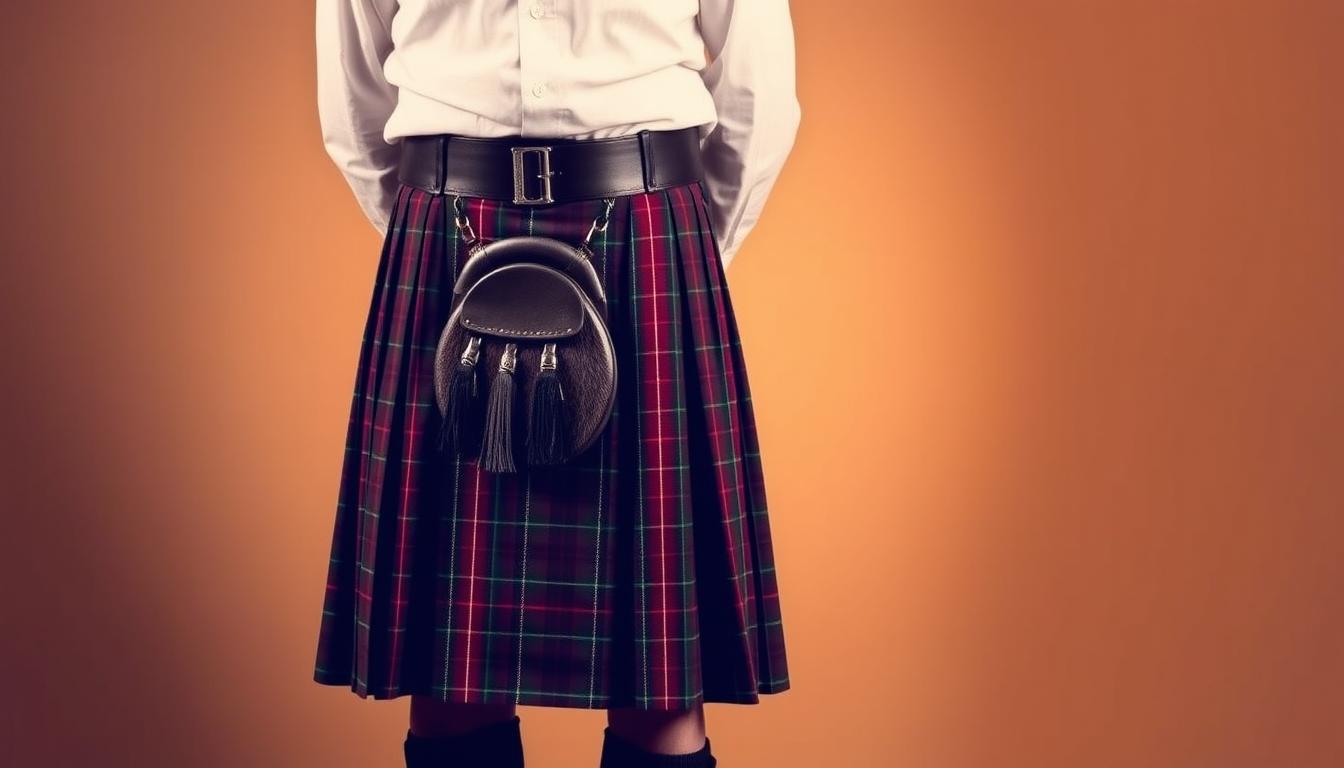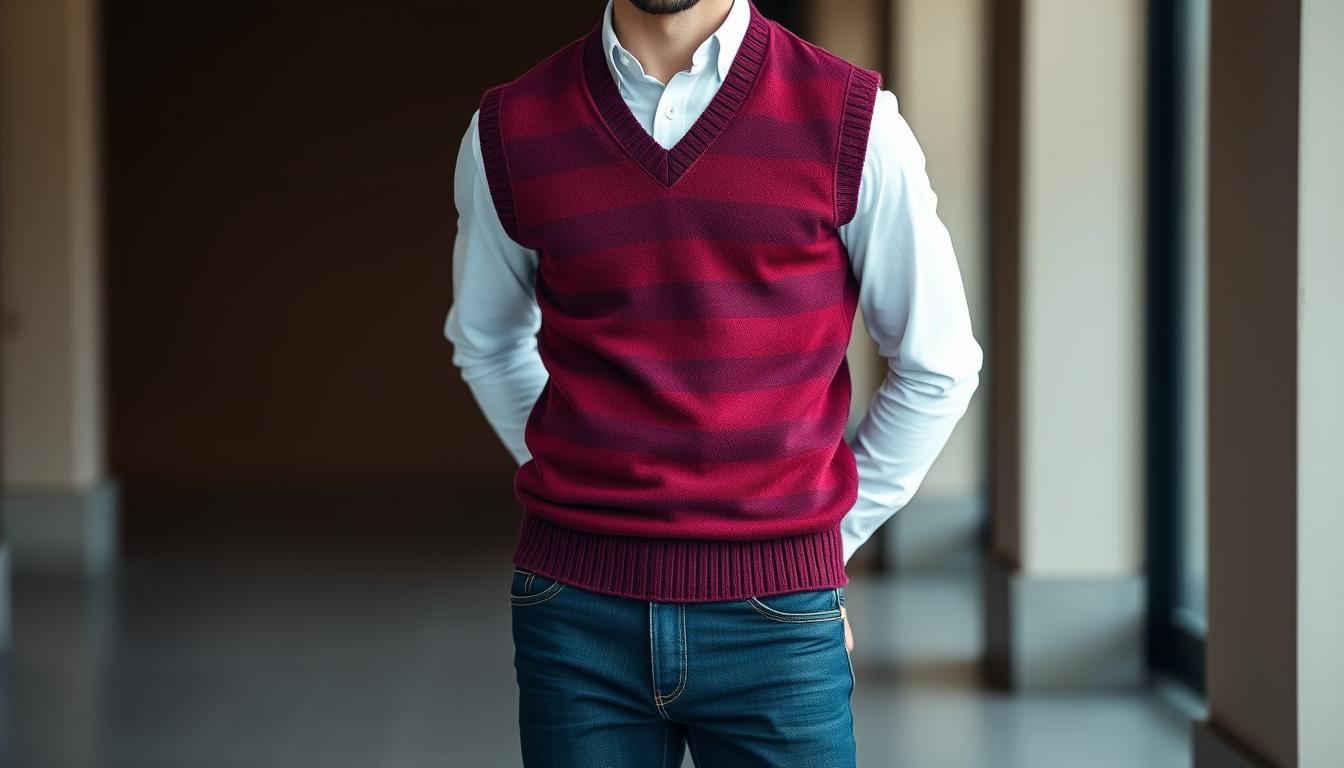Exploring how to wear a kilt is a journey into Scottish culture and personal style. It goes beyond regular fashion. Whether you’re celebrating your heritage, going to a special event, or just want to try traditional dress, learning to wear a kilt is more complex than you think.
Kilts are more than clothes; they’re a strong symbol of cultural identity and personal style. They feature detailed tartan patterns and specific ways to wear them. To master wearing a kilt, you need to know both the old traditions and modern fashion.
This guide will cover everything about kilt wearing, from picking the right one to styling it with confidence. You’ll learn key techniques that turn this iconic Scottish garment into a stunning fashion statement.
If you’re Scottish or just love this unique clothing tradition, you’ll find useful tips to wear a kilt authentically and stylishly. Get ready to learn the secrets of this timeless piece and enjoy a unique fashion experience.
Key Takeaways
- Learn authentic kilt wearing techniques
- Understand cultural significance of traditional dress
- Master proper kilt positioning and fit
- Explore versatile styling options
- Discover accessories that complement your kilt
Understanding the History and Significance of Scottish Kilts
Scottish kilts are more than just clothes. They tell a story of Scottish culture and history. From practical wear to a symbol of national pride, kilts have come a long way.
Origins of Highland Dress
The first kilts were for Highland warriors and farmers. They were made for the rough Scottish terrain:
- Lightweight and breathable design
- Easy movement during physical labor
- Protection from harsh mountain climates
- Adaptable to various weather conditions
Evolution Through Centuries
Over time, kilts changed from useful clothes to cultural symbols. The Great Kilt (or Féileadh Mòr) was the first full-body garment. It evolved into the kilt we know today.
Cultural Importance Today
Kilts are a big part of Scottish fashion today. They are worn at weddings, ceremonies, and cultural events. Kilts connect Scotland’s past to its present, showing pride in heritage.
- Represents national identity
- Honors family clan heritage
- Showcases traditional craftsmanship
- Connects generations through shared tradition
Essential Components of Traditional Kilt Attire
Learning to wear a kilt is more than just putting on clothes. It’s about knowing the detailed parts that make up a true highland dress. Our guide will show you the key pieces that turn a simple outfit into a beautiful Scottish look.
When learning about highland dress etiquette, there are a few main parts to a classic kilt outfit:
- The Kilt: Handcrafted wool garment with precise pleating
- Sporran: Decorative leather pouch worn at the front
- Kilt Jacket: Tailored blazer or traditional tweed coat
- Dress Shirt: Crisp white or tartan-patterned
- Accessories: Sgian-dubh (small knife), kilt pin
Now, let’s look at each part with care and flair:
| Component | Purpose | Style Tip |
|---|---|---|
| Kilt | Primary garment | Ensure proper waist placement and pleating |
| Sporran | Functional accessory | Match leather to jacket formality |
| Jacket | Upper body coverage | Select based on occasion (casual or formal) |
Knowing these parts helps you create a perfect highland dress look. It respects Scottish traditions and shows off your personal style.
Selecting the Right Tartan for Your Heritage
Exploring tartan is like unlocking a vibrant piece of Scottish culture. Our advice goes beyond just picking fabric. It’s about connecting with a rich tradition that tells your story. Whether you’re tracing your Scottish roots or just love stunning design, understanding tartan patterns can take your fashion to the next level.
Scotland fashion tips begin with knowing tartan basics. These patterns aren’t random designs. They represent family history, regional pride, and personal expression.
Understanding Clan Tartans
Clan tartans are deeply personal, representing Scottish family heritage. Each pattern has its own story through color combinations and weaving. When choosing a clan tartan, consider these key points:
- Verify your family’s specific clan pattern
- Research the historical significance of your family’s colors
- Check authentic registration with Scottish heritage organizations
Universal Tartans for Non-Scots
Not everyone has Scottish roots, but you can wear tartan. Universal tartans are beautiful options for fashion lovers everywhere. These designs are inclusive and stylish, letting anyone embrace Scottish textile traditions.
Modern Tartan Designs
Modern tartan designs are pushing traditional boundaries. Designers are mixing classic patterns with bold colors and new weaving techniques. From runways to street style, modern tartans bring Scottish heritage into today’s fashion.
- Experimental color palettes
- Minimalist pattern interpretations
- Cross-cultural design influences
How to Wear a Kilt: Basic Steps and Instructions
Learning to wear a kilt might seem hard, but we make it easy. Our guide turns kilt wearing into simple steps. You’ll look great and feel confident quickly.
First, let’s cover the basics of putting on a kilt. It needs some care and practice. Here are the main steps:
- Unfold the kilt completely and lay it flat
- Position the kilt around your waist, ensuring the pleats are at the back
- Adjust the kilt so it sits comfortably at your natural waistline
- Secure the first leather strap on the right side
- Fasten the second leather strap on the left side
When wearing a kilt, being precise is key. The kilt should fall to the middle of your knee. This creates a clean, traditional look. Make sure the pleats are crisp and aligned.
Pro tip: Practice in front of a mirror to get it right. A well-fitted kilt boosts your confidence and style.
- Check that the tartan pattern is centered
- Ensure the kilt hangs evenly on both sides
- Adjust the waist straps for a comfortable fit
Wearing a kilt is an art that blends tradition with personal flair. Feel free to add your touch while keeping the classic style.
Proper Kilt Length and Positioning
Learning to wear a kilt is an art that blends tradition with personal flair. It’s important to get the fit right for both comfort and style.
The right kilt length is key to traditional Scottish attire. A well-fitted kilt should hit just at or above the knee. This creates a clean, elegant look.
Measuring for the Perfect Fit
Getting your measurements right is the first step to a perfect kilt. Here’s how to measure for a great fit:
- Measure your waist at the natural waistline
- Determine your hip circumference
- Check the desired kilt length from waist to knee
Placement on the Body
Where you place your kilt is important for a true look. Pro tip: The kilt should sit at your natural waistline, just above the hip bones.
| Measurement Point | Recommended Position |
|---|---|
| Waist | Natural waistline |
| Length | Top of knee |
| Pleats | Centered at back |
Common Fitting Mistakes to Avoid
Even those who wear kilts often can make mistakes. Here are common errors to watch out for:
- Wearing the kilt too low or too high
- Incorrect waist measurement
- Ignoring personal body shape
- Neglecting proper pleat alignment
Wearing a kilt is about feeling confident and comfortable. Take your time to adjust and find your perfect fit. You’ll look amazing in this classic garment.
Choosing Appropriate Kilt Accessories
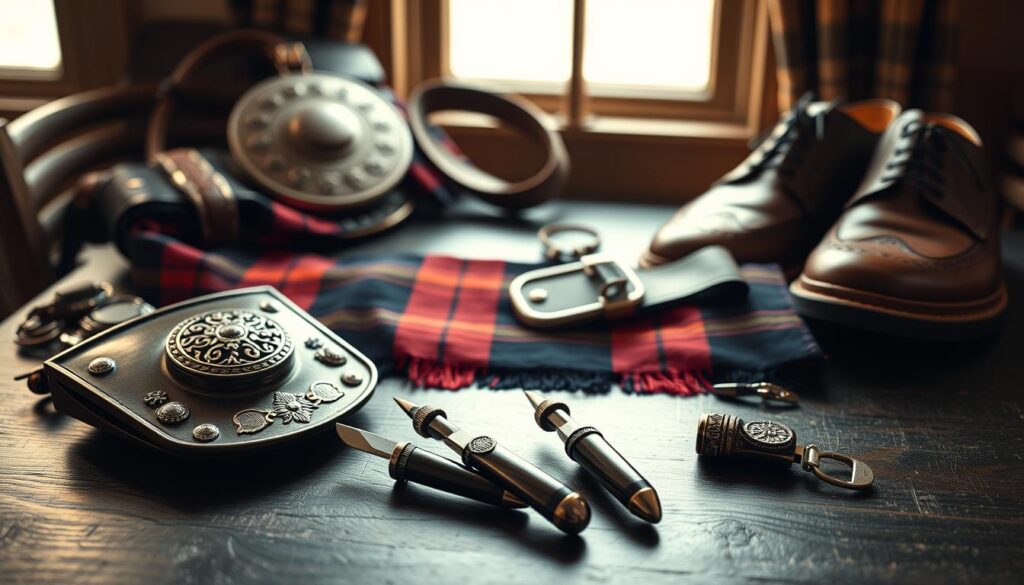
Accessories are key to making a traditional Scottish outfit stand out. They turn a simple kilt into a stunning ensemble. Knowing which pieces to choose is part of highland dress etiquette.
Let’s look at the essential accessories for a remarkable kilt outfit:
- Sporran: A leather pouch at the front of the kilt, for both function and style
- Sgian-dubh: A small ceremonial knife tucked into the right sock
- Kilt pin: A decorative piece for the front apron of the kilt
- Clan badge or tartan brooch: A symbol of family heritage
Think about the occasion when picking accessories for your traditional Scottish attire. Formal events need more elaborate pieces. Casual settings are better with simpler, understated choices.
Pro tip for highland dress etiquette: Match your metal accessories (like belt buckles and sporran chains) for a cohesive look. Silver or brass tones look great with most tartan patterns.
Remember, accessories are more than just decorations. They tell a story, connecting you to Scottish cultural traditions.
Sporran Selection and Placement Guide
The sporran is more than just an accessory in kilt wearing instructions. It’s a key part of ceremonial kilt attire, blending function and style. This traditional Scottish pouch is handy for carrying essentials and adds a unique flair to your Highland outfit.
Knowing the different types of sporrans is vital for a complete kilt look. Let’s dive into the various options that can enhance your ceremonial kilt attire:
Types of Sporrans
- Day Sporrans: Practical leather pouches for casual wear
- Dress Sporrans: Ornate designs with metalwork for formal events
- Semi-Dress Sporrans: Versatile options bridging casual and formal styles
- Hunting Sporrans: Rugged leather designs with functional appeal
Proper Positioning
Getting the sporran’s placement right is key in kilt wearing instructions. It should hang centered on the front of the kilt, about 6-8 inches below the waistline. Make sure it’s comfortable and doesn’t get in the way of your movements.
Occasion-Specific Choices
Choosing the right sporran depends on the event and your style. For weddings and formal ceremonies, go for detailed dress sporrans with metalwork. For casual gatherings, simpler leather designs work best.
- Formal Events: Elaborate silver or brass-mounted sporrans
- Casual Outings: Simple leather sporrans with minimal decoration
- Highland Games: Functional sporrans with practical storage
Pro tip: Choose a sporran that matches the event’s formality. A well-chosen sporran can take your ceremonial kilt attire from good to extraordinary.
Footwear and Sock Considerations
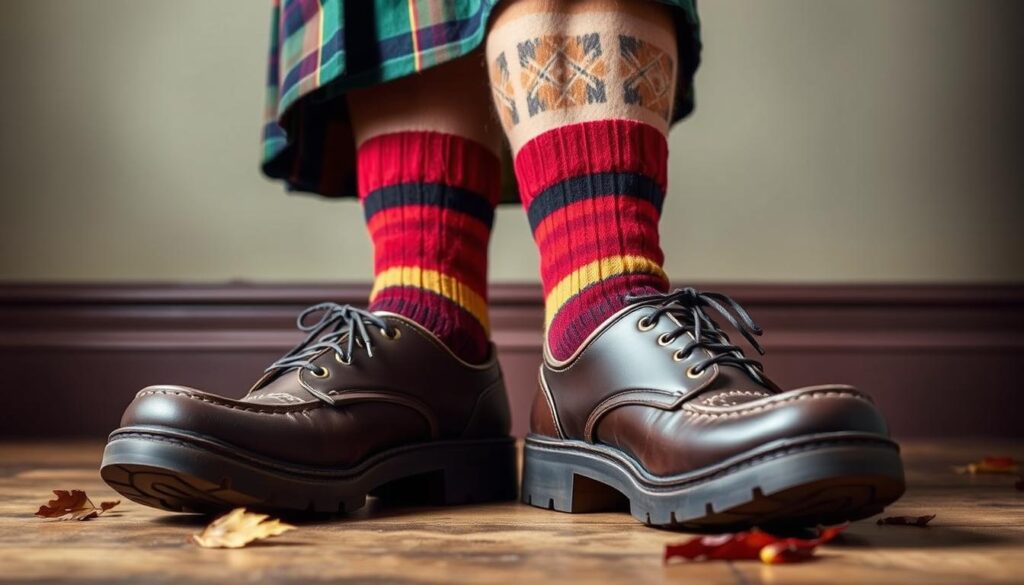
Learning to style a kilt well means paying close attention to your shoes and socks. The right shoes can make or break your Scottish outfit. Traditional Scottish fashion tips stress the need for matching shoes with your kilt.
Here are some top picks for shoes:
- Ghillie Brogues: The classic choice for formal kilt wear
- Dress boots for a modern twist
- Leather oxford shoes for versatile styling
Choosing the right socks is just as important. Kilt hose, or traditional Scottish knee-high socks, are usually made of wool. They come in many tartans and solid colors. Matching your socks to your kilt or picking a color that goes well with it can make your outfit look great.
Scotland fashion tips for socks include:
- Wear traditional sock flashes for authentic Highland dress
- Choose wool socks for comfort and traditional appearance
- Select colors that coordinate with your kilt’s tartan
Think about the event when picking your shoes. For formal events, go for traditional choices like ghillie brogues. For casual settings, you can opt for more modern takes on Scottish style.
The right shoes and socks can turn your kilt into a bold statement of personal style and cultural appreciation.
Kilt Maintenance and Care Tips
Keeping your traditional Scottish attire in top shape is key. A well-kept kilt looks great and lasts longer. It’s perfect for many events.
There are important steps to keep your kilt in great condition. Knowing how to wear it is just as important as knowing how to care for it.
Essential Cleaning Methods
Cleaning a kilt needs care and the right techniques. Each fabric type has its own cleaning method:
- Wool kilts need professional dry cleaning
- Spot clean minor stains right away
- Use special brushes for wool
- Never machine wash a kilt
Smart Storage Solutions
Storing your kilt right helps keep it looking good:
- Hang kilts on padded hangers
- Keep them in cool, dry places
- Use garment bags for extra protection
- Stay away from direct sunlight
Professional Care Recommendations
At times, you’ll need a pro to keep your kilt in top shape. Here are some services to consider:
| Service Type | Recommended Frequency |
|---|---|
| Professional Cleaning | 1-2 times per year |
| Repairs and Alterations | As needed |
| Fabric Restoration | Every 3-5 years |
Spending time on kilt care ensures it stays a valued part of your wardrobe for years.
Dressing for Different Occasions
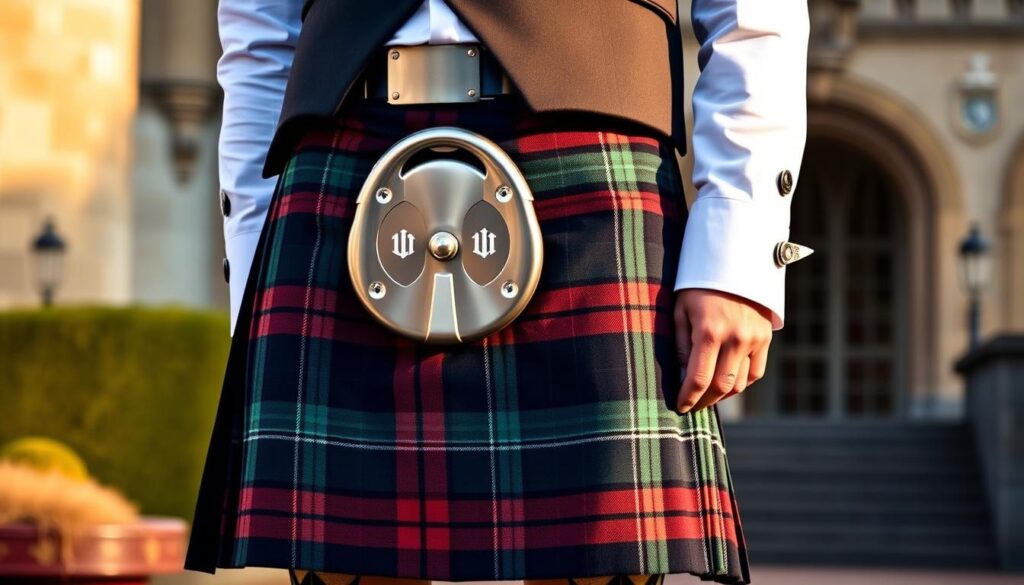
Learning about ceremonial kilt attire means knowing the dress codes for different events. Whether it’s a wedding, a professional meeting, or a casual get-together, your kilt can make a big statement.
At formal events, highland dress etiquette calls for precision and elegance. Here are the key guidelines for different events:
- Weddings: Go for a classic tartan with formal accessories like a Prince Charlie jacket and bow tie
- Business Events: Pick neutral-toned kilts with crisp dress shirts and tailored jackets
- Casual Outings: Choose lightweight fabrics and pair with modern tops for a laid-back look
At work, you want to look subtle yet sophisticated. A well-fitted kilt shows cultural pride while keeping you polished. Choose muted tartans that match your work clothes.
Sporting events and cultural festivals are great for showing off your kilt. Here, you can try bolder patterns and traditional accessories to show your style.
Highland dress etiquette is about confidence and respect for the garment’s heritage. Each event is a chance to show your unique personality through this timeless piece of clothing.
Modern Styling Tips for Contemporary Kilt Wear
Turning traditional Scottish clothes into modern fashion is simpler than you think. Our men’s kilt styling guide shows you how to move beyond old dress codes. It’s about embracing a new, urban way to wear kilts.
To update your Scotland fashion tips, mix classic Highland wear with today’s street style. The goal is to create unique yet balanced looks. These should show off both tradition and your personal style.
Casual Urban Combinations
Here are some smart ways to wear kilts in everyday life:
- Leather motorcycle jackets for an edgy contrast
- Graphic band t-shirts for a rebellious touch
- Sleek sneakers instead of traditional brogues
- Denim jackets for a relaxed, modern aesthetic
Street-Smart Styling Strategies
Our men’s kilt styling guide suggests paying attention to color and texture. Dark, neutral tartans pair well with modern city outfits.
| Kilt Style | Perfect Urban Pairing | Recommended Occasion |
|---|---|---|
| Classic Tartan | Black leather jacket | Night out |
| Neutral Tone Kilt | White graphic tee | Casual daytime |
| Modern Cut Kilt | Bomber jacket | Music festival |
Pro tip: Confidence is your ultimate accessory when sporting a contemporary kilt look.
Common Mistakes to Avoid When Wearing a Kilt
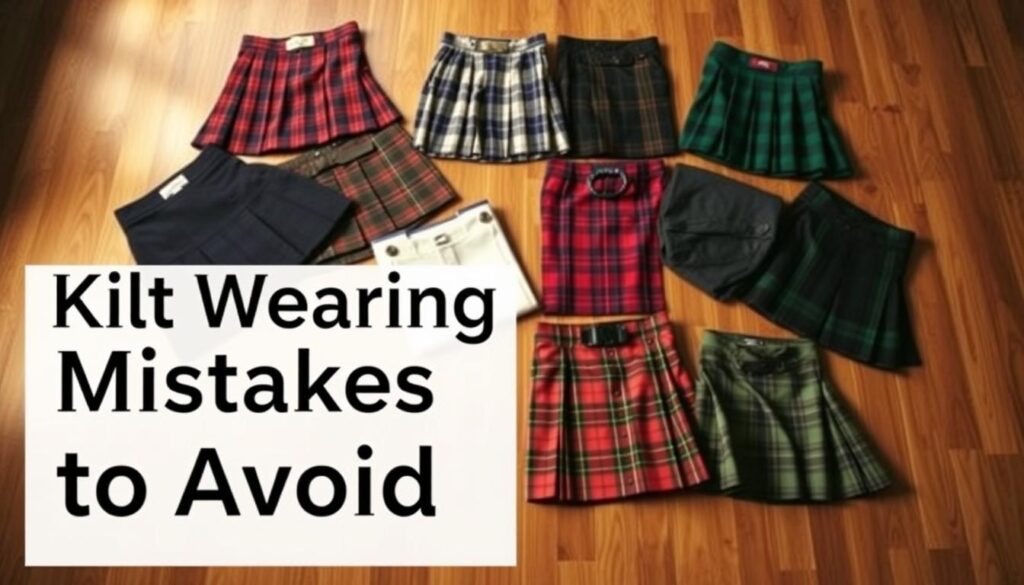
Wearing a kilt can be tricky for beginners. Many people make mistakes that affect their look and respect for the culture.
Here are some key mistakes to watch out for:
- Incorrect Kilt Length: Your kilt should hit just above the knee, not mid-thigh or ankle-length
- Sporran Positioning: Never wear the sporran too high or too low – center placement is key
- Belt Misalignment: Ensure your kilt belt sits at the natural waistline
- Accessory Overload: Less is more – don’t pile on too many traditional accessories
Getting the kilt right is all about precision. Steer clear of these common errors to show respect for Scottish attire.
It’s also important to know about fabric and fit. A good kilt fits well and moves with you. It should look neat and structured.
- Check pleat alignment
- Ensure proper waist measurement
- Select quality tartan fabric
- Practice correct draping techniques
By focusing on these details, you’ll wear your kilt with confidence and respect for the culture.
Weather Considerations and Seasonal Adaptations
Learning to wear a kilt means knowing how to adjust it for different weather. Our Scotland fashion tips will guide you through seasonal challenges. You’ll stay stylish and comfortable.
In summer, go for lightweight fabrics and smart layering. Choose breathable wool tartans that keep you cool. Wear light cotton undershirts for comfort on warm days.
- Select lightweight wool for summer kilts
- Use moisture-wicking underlayers
- Opt for lighter tartan colors
For winter, layering is key. Wear thick wool kilts with thermal leggings for warmth. Wool keeps you cozy in cold weather.
- Layer with merino wool sweaters
- Add heavyweight thermal undergarments
- Consider wind-resistant sporran covers
Rainy days require special care. Use waterproof outer layers and quick-drying materials. Water-resistant wool blends keep you dry while staying true to Scottish style.
Spring and autumn need flexible clothing choices. Mix lightweight and medium-weight layers. This way, you can adjust to changing temperatures all day.
Special Event and Ceremonial Kilt Etiquette
Understanding ceremonial kilt attire is key for formal events. Our guide will teach you to wear a kilt with confidence and respect.
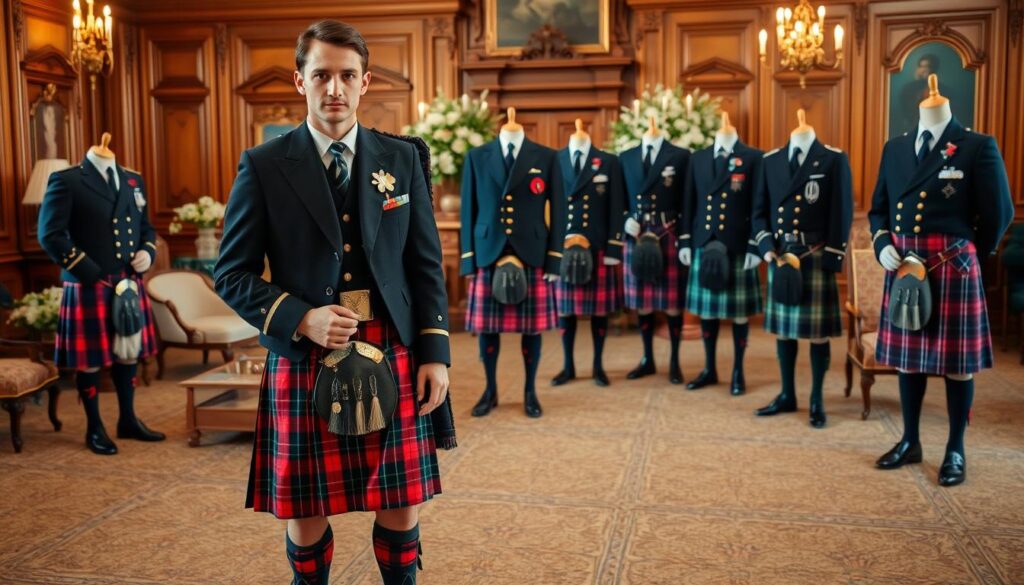
Ceremonial kilt wear is more than fashion. It’s a cultural expression needing precision and knowledge of event protocols.
Wedding Protocols
At a Scottish wedding, following highland dress etiquette is important. The right approach shows respect and enhances your presence.
- Choose a tartan that represents your connection to the wedding party
- Ensure your kilt is freshly pressed and immaculately presented
- Coordinate accessories to match the wedding’s formality
Formal Event Considerations
Each formal event has its own kilt attire needs. Knowing these nuances shows cultural sophistication.
| Event Type | Recommended Attire | Accessory Guidelines |
|---|---|---|
| Black Tie Gala | Formal Highland Evening Dress | Formal sporran, dress sgian-dubh |
| Daytime Ceremony | Daytime Formal Kilt | Lighter sporran, traditional accessories |
Military Traditions
Military ceremonial kilt attire is the peak of highland dress etiquette. Each part has deep symbolic and historical meaning.
- Precise pleating and positioning of the kilt
- Specific placement of military medals
- Regulation sporran and belt requirements
Mastering ceremonial kilt attire is an art. It blends respect for tradition with personal style. By following these guidelines, you’ll move through formal events with grace and authenticity.
Conclusion
Exploring how to wear a kilt shows it’s more than clothes—it’s a statement of style and culture. We’ve learned about picking the right tartan, finding the perfect fit, and adding accessories. These steps turn a simple kilt into a stylish outfit.
Advice on tartan outfits is about showing your unique self. Whether it’s for a formal event, urban fashion, or celebrating Scottish heritage, a kilt is versatile. The most important thing is to wear it with confidence, knowing its history and modern appeal.
This guide has given you the tools to understand kilts. You now know how to choose accessories and grasp cultural aspects. Fashion is about expressing yourself, and a kilt is a great way to do that.
When you wear your kilt, you’re not just dressing up—you’re carrying a tradition and telling a story. You’re making a bold fashion statement. Slàinte mhath!

